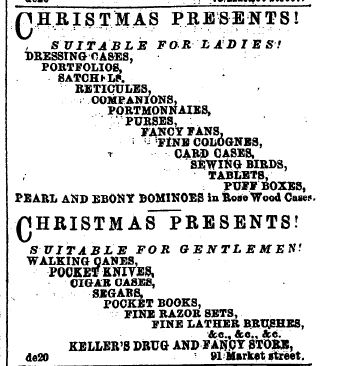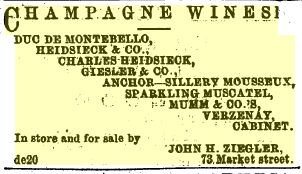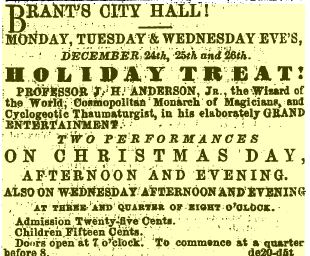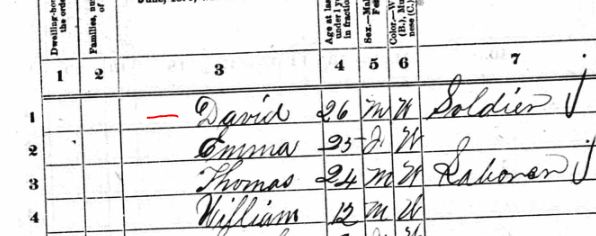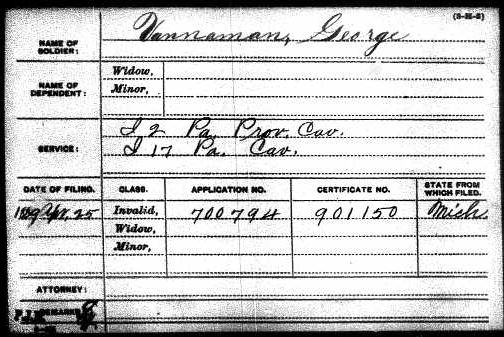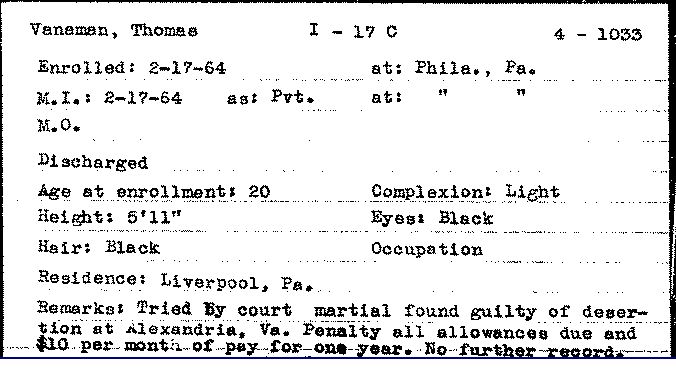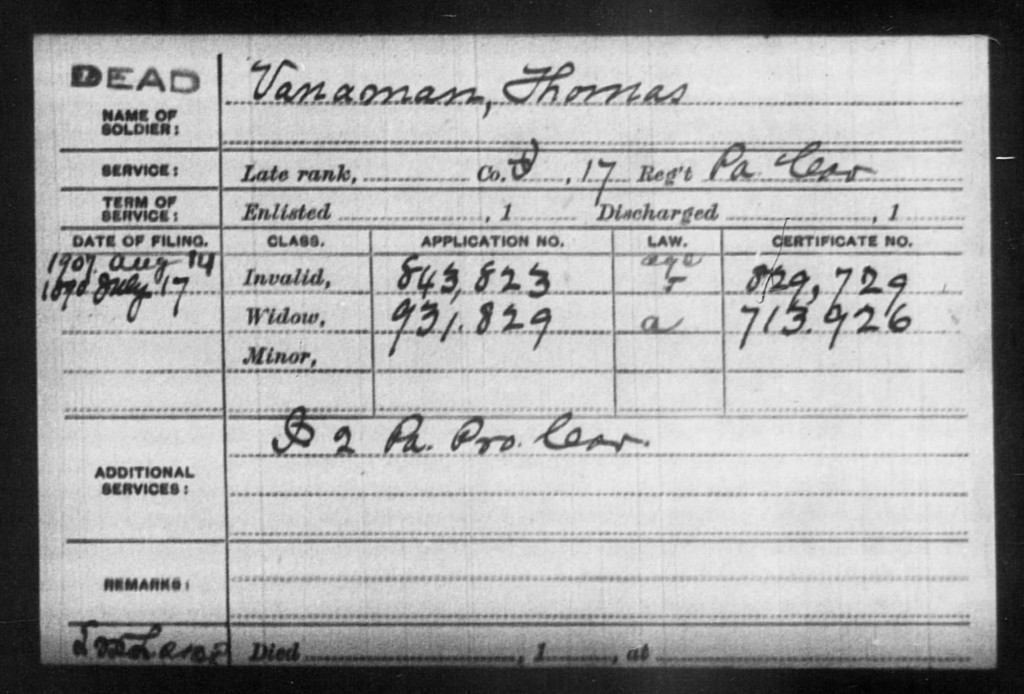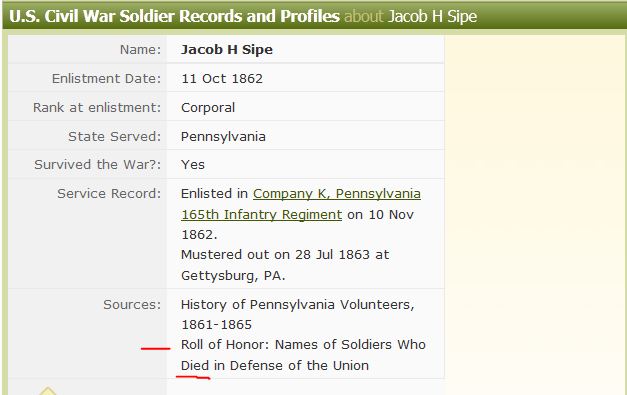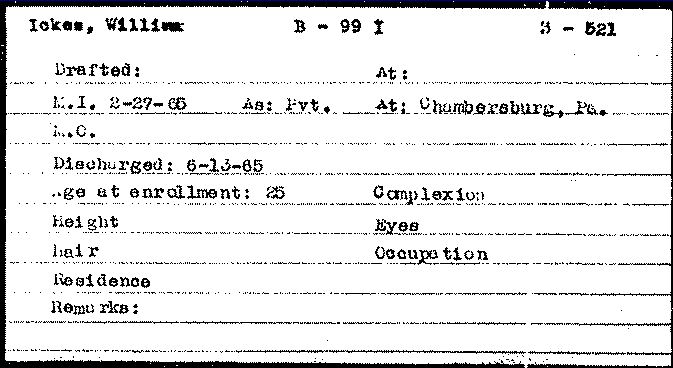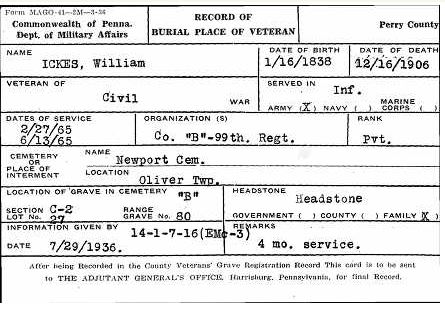Posted By Norman Gasbarro on November 30, 2012
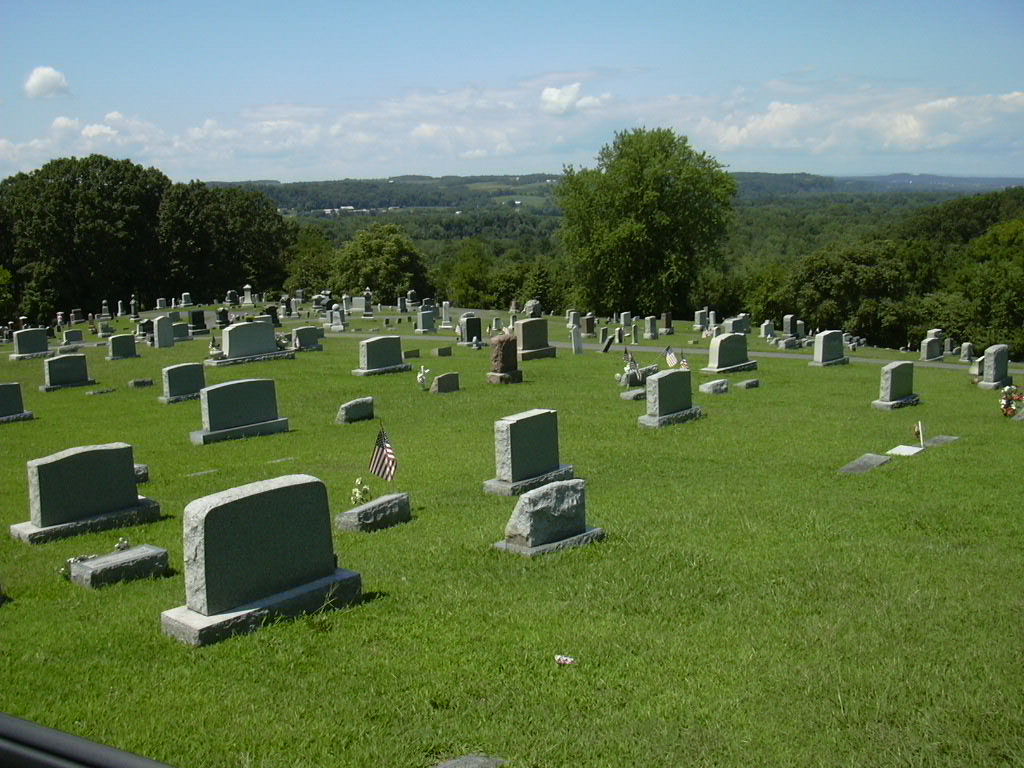
In a section describing John A. Sipe, found in the Genealogical and Biographical Annals of Northumberland County Pennsylvania (1911), no less than ten Civil War veterans are mentioned in his extended family. John A. Sipe was a merchant tailor who had a post-Civil War business that centered in Herndon, Northumberland County, Pennsylvania, but operated in the rail and river corridor from Millersburg to Sunbury.
In today’s post the full biographical entry will be presented along with follow-up information about the military service of John A. Sipe his father, Jacob Sipe, and his uncle, Jeremiah Sipe. In the post tomorrow, Jacob Henry Sipe, the brother of John A. Sipe, and William Ickes., the half-brother of John A. Sipe, will be presented. In the post on Sunday, the three Vanaman brothers’ service in the Civil War will be noted; David Vanaman, George Vanaman and Thomas Vanaman were brothers of John A. Sipe‘s wife, Eva [Vanaman] Sipe. Finally, in the post on Tuesday, the two other brothers-in-law of John A. Sipe, Monroe Chronster and Hiram M. Jacobs will be presented.
John A. Sipe of Herndon, is a resident and business man of long standing there, being the senior member of the firm of Sipe and Son, tailors, who have the only tailoring establishment in the borough and do an extensive business, having large patronage in the territory from Sunbury to Millersburg. He is a veteran of the Civil War, in which his father also served, dying of starvation in Libby Prison in 1864. Mr. Sipe is a native of York Springs, Adams County, Pennsylvania, born 5 May 1847. The family is of German extraction, his grandfather, Martin Sipe, having been born in Germany, whence he came to America before his marriage, locating at Clear Springs, in Adams County, Pennsylvania. He was a laborer and owned a small home in a glen. His wife Sarah Sipe was from White Hill, Cumberland County, Pennsylvania, and lived to the age of eighty-six years. She was the mother of twenty children, Martin Sipe being her second husband. Her children by him were: Jacob Sipe; Peter Sipe; Sallie Sipe; Leah Sipe; Jeremiah Sipe, Hettie Sipe, Maria Sipe; William Sipe; and Lena Sipe. Jeremiah Sipe, now (1910) seventy-six years old, lives at Mechanicsburg, Cumberland County, Pennsylvania. He served in the Civil War under two enlistments, in the 43rd Pennsylvania Infantry and the 17th Pennsylvania Cavalry. He was captured at the Battle of the Wilderness and was held at the noted Rebel prisons. When he went into the service he weighed over two hundred pounds, but his weight when discharged was only seventy-one pounds. His sister Leah’s husband, Nelson Day, was a soldier in the Mexican War, in which service he died.
Jacob Sipe, son of Martin Sipe, was born in 1819 in Adams County, Pennsylvania, and lived near York Springs. He was a laborer and owned a small home in Latimore Township. During the Civil War he was drafted for the Union service, but he said he would never go to the front as a drafted man and accordingly enlisted in Company B, 13th Pennsylvania Cavalry, asking to be credited to his native township as a volunteer. He had been in the service for only three weeks when captured at Sulphur Springs, Virginia, and thrown into Libby Prison, where he died in 1864, after fourteen months confinement. He is buried among the other unfortunate soldiers who perished there. His wife Ruth Day, was a daughter of Nelson Day, a native of Lancaster County, Pennsylvania, who lived to be ninety-six years old. By her first marriage, Mrs. Sipe had a son, William Ickes, who served in the Civil War as a member of the 96th Pennsylvania Volunteers [96th Pennsylvania Infantry]. To Mr. and Mrs. Jacob Sipe were born children as follows: Jacob H. Sipe, who served in the Civil War in Company L, 165th Pennsylvania Regiment (he was captured) [165th Pennsylvania Infantry]; John A. Sipe; Jennie Sipe, who married Monroe Chronster and lived at Hampton, Adams County (he was a veteran of the 93rd Pennsylvania Volunteers) [93rd Pennsylvania Infantry]; Adaline Sipe, who married Hiram Jacobs and lives at York Springs (he was a soldier in the Civil War serving with the 90th Pennsylvania Regiment)[90th Pennsylvania Infantry]; Annie Sipe, who married Emerson Fickel and lived at Lattimer, Pennsylvania (he is now deceased); and three who died in infancy. Mrs. Ruth [Day] Sipe died in 1881, aged fifty-eight years, six months, four days.
John A. Sipe was reared to farm life in the vicinity of York Springs, working thus until he was thirteen years old, when he began to learn the tailor’s trade. He served his apprenticeship in the old-fashioned way, doing anything around his employer’s house that was to be done, for the first six months of his term, cutting wood, looking after the children, or attending to any other work given to him. Then another new apprentice came, and he commenced work at the bench, after his three years of service doing journeyman work at various places in this state – Pittsburgh, Altoona, Holidaysburg, Newport, Harrisburg, Baltimore, Carlisle, Shippensburg, and Church (Cumberland County), where he remained seventeen months with a German named Cooney Draker. From there he came to Georgetown (Dalmatia), Northumberland County, and thence after a seven months stay to Herndon, which has since been his home. He arrived at Northumberland County on Whitsunday, 1867, and he was one of the earliest settlers at Herndon, which was then all woodland. He is one of the four oldest residents of the town. Mr. Sipe has seen many changes in domestic as well as civil life in his day. When he learned his trade the sewing machine was unknown, and he purchased the first sewing machine brought to Herndon. His business underwent the various changes of custom work and merchant tailoring and he has always kept abreast of the times in his line, being a first-class tradesman. In 1902 he admitted his son Harry Sipe to a partnership in the business, and Sipe and Son enjoy the best trade between Sunbury and Millersburg. They are the only tailors at Herndon. By industry and good management of his affairs, honorable dealing and intelligent use of his opportunities, Mr. Sipe has become a substantial man and his prosperity has been wholly the result of his own efforts. He began his career at Herndon in the most modest way, commencing housekeeping in a one-room house 16 by 16 feet in dimensions, and advancing his fortunes by diligence and commendable thrift.
He was married 24 October 1869 to Eve Vanaman, daughter of George Vanaman and Annie [Comfort] Vanaman, formerly of Lancaster County, Pennsylvania, later of Jersey Shore, Lycoming County, and finally of Reward, Perry County, where Mr. Vanaman lived for fifty-four years in one house, dying 3 December 1899, at the age of eighty-three years; he is buried near that place, as is also his wife. Mr. George Vanaman was a molder by occupation. His father Jacob Vanaman, was a native of Lancaster County, and moved to Jersey Shore on a canal boat, living there the rest of his life; he followed the trade of molder. Three of George Vanaman’s sons served in the Civil War: Thomas Vanaman, George Vanaman, and David Vanaman, one in the 17th Pennsylvania Cavalry.
To Mr. and Mrs. John A. Sipe were born children as follows:
(1) George Sipe, died eighteen months, four days;
(2) Annie E. Sipe, died in infancy;
(3) Mamie Sipe, died in infancy;
(4) Bessie V. Sipe, married C. M. Troutman, and they live on Sipe’s Farm in Jackson Township;
(5) Harry C. Sipe, born 1 April 1882, at Herndon, was educated in the public schools and at Central Pennsylvania College, which he attended for four terms, afterward learning the trade of tailor under his father, with whom he is now in partnership.
[Harry C. Sipe] is a member of Lodge No. 267, P. B. O. Elks, Sunbury; of Polaris Lodge, No. 765, I. O. O. F.; General Sickles Camp, No. 57; and John B. Packer Council, No. 154, Jr. O. U. A. M.
[Harry C. Sipe] married 23 February 1904, Jennie A. High, daughter of W. H. High, and they had three children, Carrie V. Sipe, Mildred M. Sipe, and one that died in infancy.
(6) Jennie A. Sipe, married Harry A. Clace, who is a weaver in the silk mills at Sunbury, where they reside, and they have one child, Geraldine Clace.
During the Civil War, though only a boy, Mr. John A. Sipe was very patriotic, and he ran away from home to Chambersburg three times to try to enlist when only sixteen. He was refused because he was under size and too light, but later when troops were needed and the conditions were not so rigid, he managed to get into the service joining Company I, 205th Pennsylvania Volunteer Infantry [205th Pennsylvania Infantry], 2 August 1864, at Harrisburg, where Camp Curtin was established. He was discharged 7 Jun 1865, after the close of the war. Mr. Sipe saw considerable service, participating in the operations at Fort Stedman, Virginia, 25 March 1865; and was with his regiment when it led the charge of the 2nd Brigade, 3rd Division, 9th Army Corps on Fort Mahone, 2 April 1865, in front of Petersburg. On 10 December 1864, the 3rd Division of the 9th Corps made a raid called the Weldon Raid, on Hatcher’s Run, having several skirmishes with the enemy, He served under Capt. J. C. Machan, of Hollidaysburg, Pennsylvania, and Lieutenant Colonel Walters of Lancaster County. He is a member of John J. Arnold Post, No. 407 [G.A.R.], and of the Sons of Veterans at Herndon (Sickles Camp No. 57), and he is also associated fraternally with Lodge No. 551, I.O. O. F. (Source: Annals of Northumberland County, p. 627-628, edited/re-formatted for blog/web searching].
——————————
JOHN A. SIPE (1847-1934)

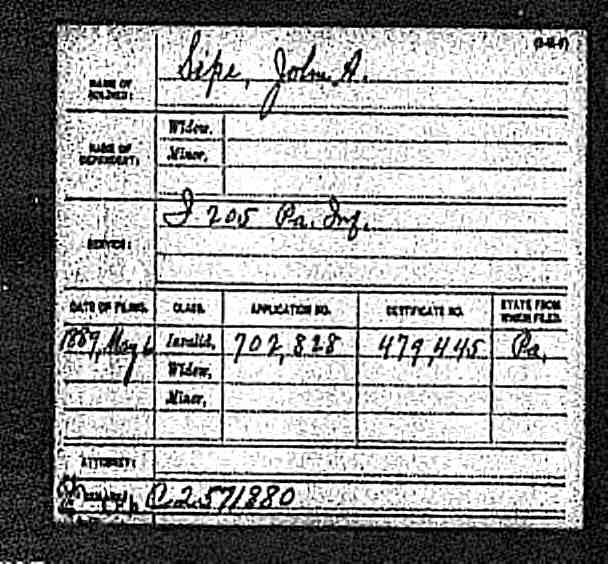
John A. Sipe was mustered into the 205th Pennsylvania Infantry, Company I, as a Private, on 1 September 1864 and served to his discharge on 2 June 1865. After the Civil War he married Eva Anna Vanaman. In 1889, he applied for a pension, which he received and collected until his death. In the 1890 Veterans’ Census, he didn’t indicate that he had any Civil War-related disabilities. He died in 1934, and is buried at the Herndon Cemetery, Herndon, Northumberland County, Pennsylvania. A picture of the Herndon Cemetery is at the top of this post. At present, the Civil War Research Project is looking for pictures of John A. Sipe and his family and a picture of his grave marker, as well as stories about him and his business enterprises in the area along the Susquehanna River from Sunbury to Millersburg.
——————————
JACOB SIPE (1819-circa 1863 or 1864)

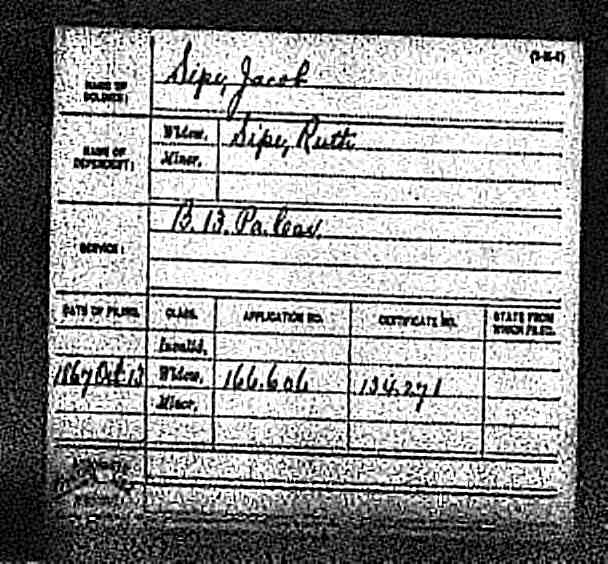
Jacob Sipe, who was born about 1819, was the father of John A. Sipe. On 10 August 1863 at Harrisburg he joined the 13th Pennsylvania Cavalry, Company B, as a Private. At the time of his enrollment, he claimed to be 40 years old, but actually was a few years older. According to records of the regiment, he was captured at Sulphur Springs, Virginia, 10 October 1863, and sent to Libby Prison where he died, it is believed some time in 1864. His widow, Ruth [Day] Sipe, applied for a survivor’s pension in October 1867, which she received until her death in 1881. At this time, his place of burial has not yet been identified, although some believe that he is buried in an unmarked grave at a National Cemetery near the old Libby Prison in Richmond, Virginia.
There is another person named Jacob Sipe, from Somerset County, Pennsylvania, who was born about 1843 and served in the 142nd Pennsylvania Infantry from 22 August 1862 to his death on 17 January 1863 at the Military Asylum Home in Washington, D.C. He is buried in the U.S. Soldiers’ and Airmen National Cemetery in Washington, D.C. His mother’s name was Mary. Mary Sipe applied for her deceased son’s benefits in April 1879. This Jacob Sipe should not be confused with the one who who died at Libby Prison.
——————————
JEREMIAH SIPE (1837-1917)
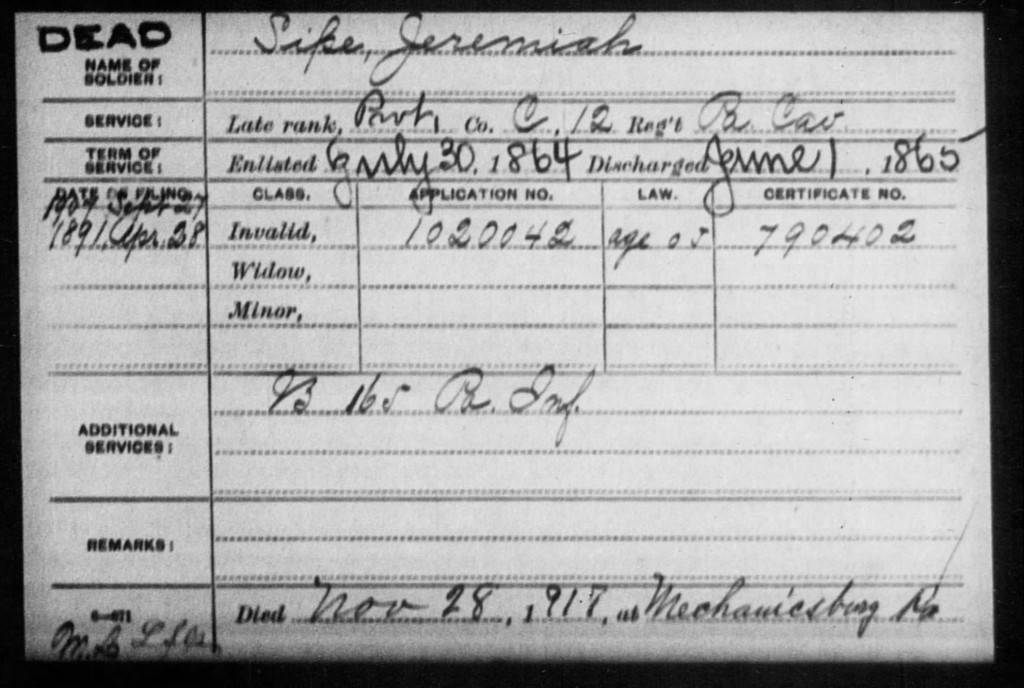

Jeremiah Sipe was a younger brother of Jacob Sipe. He was an uncle of the John A. Sipe, the tailor of Herndon. Jeremiah Sipe served in the 12th Pennsylvania Cavalry (not the 17th Pennsylvania Cavalry as stated in the Biographical Annals). On 30 July 1864, he enlisted in the said cavalry, Company C as a Private. on 6 May 1864, he was captured at the Battle of the Wilderness, Virgina, and sent to Salisbury Prison. On 16 November 1910, Jeremiah Sipe was supposed to attend the dedication ceremonies for a Pennsylvania Monument at Salisbury, North Carolina, but for some unknown reason, he did not attend. Those who attended were given a commemorative “survivor’s” badge which is pictured below.

According to the Pension Index Card, Jeremiah Sipe also served in the 165th Pennsylvania Infantry, Company B, as a Musician, from 4 November 1862 through discharge on 28 July 1863. The Pennsylvania Veterans Index Card, referencing records at the Pennsylvania Archives, is shown below.

Jeremiah Sipe married Rachel Hutton.
It should be noted that the Biographical Annals is in error on the regimental designation when it says that Jeremiah Sipe served in the 43rd Pennsylvania Infantry.
Jeremiah Sipe died on 28 November 1918 at Mechanicsburg, Pennsylvania. He is buried at the Mechanicsburg Cemetery.
——————————-
Pension Index Cards are from Fold3 and Ancestry.com.
Category: Research, Resources, Stories |
Comments Off on John A. Sipe – Tailor of Herndon
Tags: Dalmatia, G.A.R., Georgetown, Herndon, Jackson Township, Millersburg
 ;
;
